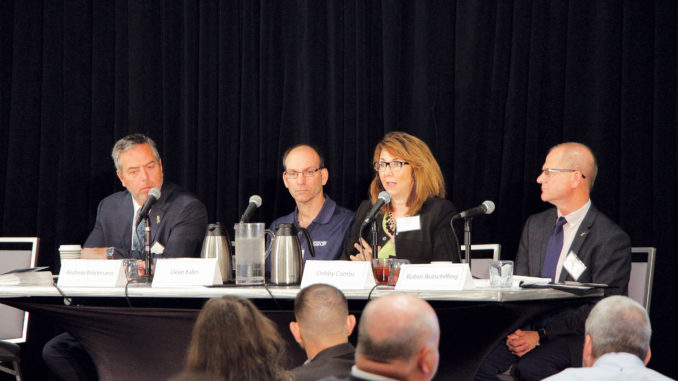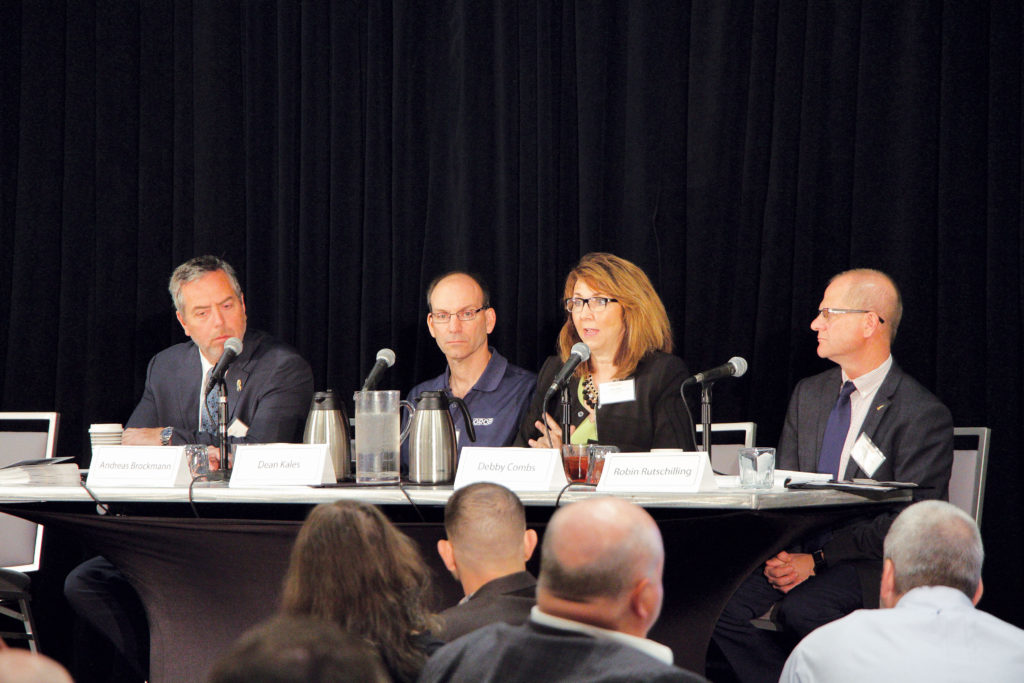
Leaders in the manufacturing industry gathered in West Chester to talk about talent development and retention
By Kevin Michell
Even though 1 in 8 Ohio jobs are in the manufacturing sector and the state has seen a 14% increase in those jobs over the last nine years, manufacturing companies face a talent crunch. Qualified and skilled workers have lately left the industry in droves and a lack of students entering the field after school has left manufacturers with more questions than answers regarding how to find, attract and retain talented employees.

This predicament provided the backdrop for Ohio Business Magazine’s second annual Ohio Manufacturing Summit. Early in the morning of May 16, representatives of manufacturing companies, higher learning institutions, municipalities and many other organizations gathered at Centre Park of West Chester’s event center to participate in networking and hear a panel discussion on the workforce challenge facing the industry.
Moderated by Greg Knox of Knox Machinery in Franklin, the roundtable participants included Andreas Brockmann, head of technical training for Festo Didactic in Mason; Debby Combs, director of advanced manufacturing for Cincinnati’s Partners for a Competitive Workforce (PCW), a United Way initiative; Dean Kales, training instructor at Grob Machining in Bluffton; and Robin Rutschilling, operations manager for Clippard Instrument Lab in Colerain, a suburb of Cincinnati.
After introductions from Ohio Business Magazine’s Brad Hoicowitz and its president, Eric Harmon, the discussion kicked off in earnest and largely focused on getting young people on the verge of entering the workforce to fill the manufacturing industry talent gap.
Combs and PCW have worked on building the skills of the present and future workforce in Ohio, Kentucky and Indiana for more than a decade. In her work focusing on manufacturing for PCW’s Advanced Manufacturing Industry Partnership (AMIP), Combs stressed the importance of developing partnerships—even among otherwise competing manufacturers—and knowledge sharing.
“All of us have a vested interest in assuring that manufacturing careers are seen as viable, living-wage, excellent careers,” she said. “So, we’re all working together as a team to do that.”
These partnerships are guided by AMIP’s strategy for connecting a talent pipeline between educators and employers, emphasizing a commitment from manufacturers to work with schools and organizations like Partners for a Competitive Workforce to create opportunities that show students a viable, dynamic path from schools like Great Oaks and Butler Tech to long careers for companies like Clippard and Knox. And it’s not just about winning over the students—Combs pointed out it’s every bit as important to convince moms and dads that this line of work is viable, stable and far improved from the days of dangerous, dirty and loud shop floors.
Knox, moderating this edition of the summit after helping Ohio Business Magazine bring it to life last year, noted that AMIP and Combs’ work had created an important and valuable link in the region between employers, students and schools while also agreeing on the importance of educating parents of students that manufacturing doesn’t have the negative connotations it had 30 or 40 years ago.
All the panelists agreed that schools aren’t the only venue where advanced manufacturing education and training should happen. Companies like Clippard bring in high school juniors and seniors for job shadowing and on-site experiential learning. Rutschilling thanked the educators in attendance for their role in steering interested students towards the potential in manufacturing and creating curricula that allow for whole days of each week to be spent learning at job sites.
Brockmann and Kales both work for German-owned companies and pointed out the benefits of European-inspired apprenticeship programs. With regards to Festo Didactic in particular, its Mechatronics Apprentice Program Partners initiative allows employers—even ostensible competitors to Festo—to enroll employees or working students in training for the skills that are crucial to the present and future of manufacturing. The two-year program has students spend two days a week on learning at Festo and Sinclair Community College, with graduates receiving an associate degree in mechatronics.
“This is very important, to partner with a college,” Brockmann said. “You have to find a good school. It’s not just about what your needs are, (it’s) what the kids need for their career.”
Grob, as well, quickly adopted apprenticeship as a way to train young people and get them involved and interested in a manufacturing career. Being in Bluffton, the company works hard to be a visible and active employer to the surrounding area, including nearby cities Lima and Findlay.
“We do a lot of outreach,” Kales said. “Our doors are always open—we have schools coming in all the time, bringing a STEM class in or just bringing juniors and seniors in.”
Working with Rhodes State College in Lima, Grob brings students into its training department for three days of the week and provides specialized on-the-job training over the course of the four-year program.
During Grob’s 29 years in Bluffton, 367 employees have come from the apprenticeship program (including 20 that just started in June), of which 64% still work for Grob including three senior managers, nine supervisors and 10 foremen.
Kales and Rutschilling both stressed the importance and the benefits both of their companies have seen by investing real money and time into training students and recent entrants to the labor force. But retaining young talent involves more than simply paying for their manufacturing-focused education.
“The important thing is staying involved with your students from when you first meet them,” Rutschilling observed before adding that Clippard’s involvement with nine area schools allowed the company to find the right programs for each student’s unique need. “To retain them, you have to figure out what their passions are, what they like to do.”
After a round of audience questions, the discussion closed with a final piece of advice for the Great Oaks students in attendance, with Knox stating that manufacturers are becoming more willing to invest in and spend on students that want to commit to this career path but they’re looking for quality “attitude and aptitude.”
After the event, attendees and panel participants stayed to converse with representatives from the summit’s partners and sponsors, which included EGC Construction, the Tristate Tooling and Manufacturing Association, Commerce Bank, Von Lehmann CPA & Advisory Firm and Great Oaks Career Campuses.



